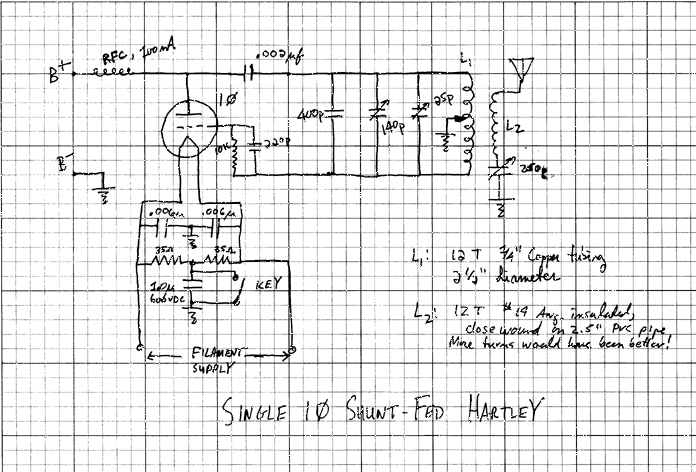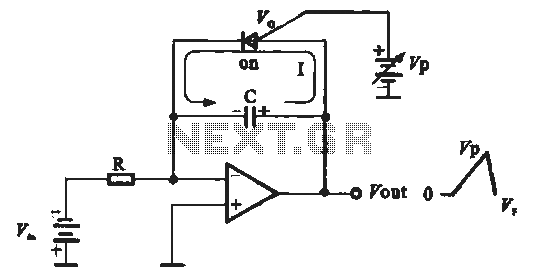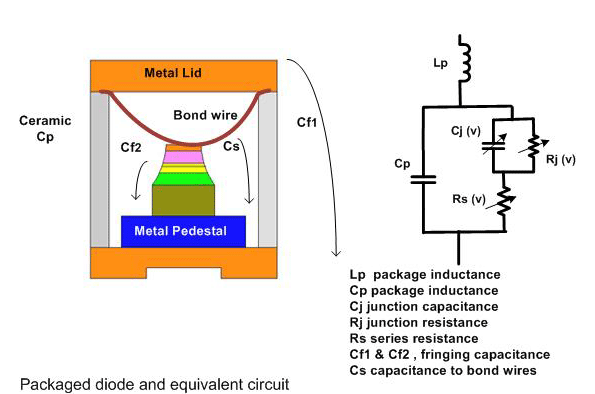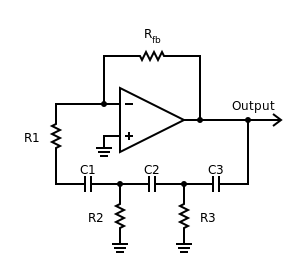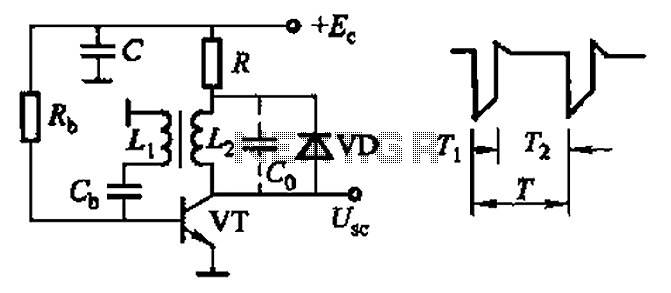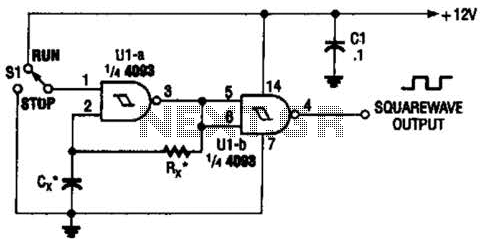
LC feedback Oscillator
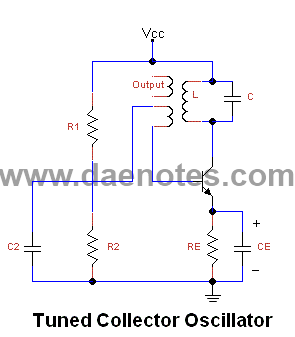
These are resonant circuits or tank circuit oscillators. They are commonly used to produce high frequencies ranging from 1 MHz to 500 MHz; hence, they are also known as RF oscillators. These oscillators are utilized in RF generators, radio transmitters, and receivers. Some popular IC feedback oscillators include the Hartley oscillator, which is widely used as a local oscillator in radio receivers. The main advantages of this oscillator are its wide frequency range and ease of use. The circuit of the Hartley oscillator features a tank circuit consisting of two coils, L1 and L2. Coil L1 is inductively coupled to coil L2, and this combination functions as an autotransformer. A coil known as a radio frequency choke (RFC) is connected between the collector and the Vcc supply. It serves as a load for the collector while permitting the flow of DC current but blocking AC current. Feedback between the output and input circuit is achieved through autotransformer action, which introduces a phase shift of 180 degrees. The phase reversal between the output and input voltage occurs because they are taken from opposite ends of coils L1 and L2 with respect to the grounded tap. The tap on the combination of L1 and L2 coils is connected to the transistor emitter terminal via ground and through the capacitor CE. Since the transistor also introduces a phase shift of 180 degrees, the total phase shift is 360 degrees, resulting in positive feedback. The capacitor Cc, connected between the collector and the tuned circuit, allows only AC currents to pass to the tank circuit, effectively blocking DC current. The capacitor CB, referred to as a blocking capacitor, further prevents DC current from reaching the base. Resistors R1, R2, and RE are employed to provide DC bias to the transistor. The Colpitts oscillator is widely used in commercial signal generators for frequencies between 1 MHz and 500 MHz. It is similar to the Hartley oscillator with minor modifications, using two tapped capacitors instead of a tapped inductance. The frequency of oscillation, ignoring mutual inductance, can be determined by a specific relation. Points A and B are 180 degrees out of phase with each other, and another phase shift of 180 degrees is provided by the transistor itself, resulting in a total phase shift of 360 degrees between the emitter-base and collector-base circuits. When the supply is activated, capacitors C1 and C2 charge and discharge through coil L, establishing feedback to the base-emitter junction, which is amplified at the collector of the transistor. Due to positive feedback, oscillations of constant amplitude are achieved. A tuned collector oscillator circuit using a transformer also demonstrates this principle. The primary of the transformer forms a tuned circuit with capacitor C, determining the frequency of oscillation. The amplifier provides a phase difference of 180 degrees, and an additional phase difference of 180 degrees is introduced by the transformer, resulting in positive feedback. For oscillatory action, the transistor amplifier must provide sufficient gain. Resistors R1, R2, and RE provide DC bias to the transistor. Capacitors CE and C2 are bypass capacitors, ensuring that resistors RE and R2 do not affect AC operation. DC bias is supplied by resistors R1 and R2 through the low-resistance secondary winding, which also facilitates AC feedback. The output of the tuned collector oscillator is obtained through transformer coupling, with output terminals connected to the power-consuming device or the input terminals of the next stage. This connection loads the tank circuit, increasing its effective dissipative resistance and circuit losses. To maintain oscillations, additional positive feedback is required, which can be achieved by increasing transformer coupling.
The Hartley oscillator circuit exemplifies a fundamental RF oscillator configuration, facilitating the generation of high-frequency signals essential for various applications in communication systems. The inductively coupled coils, L1 and L2, enable the oscillator to operate efficiently across a wide frequency range, making it suitable for local oscillation in radio receivers. The RFC plays a critical role in ensuring that the oscillator maintains its operational integrity by allowing DC current flow while blocking AC signals, thus preserving the necessary conditions for oscillation.
The feedback mechanism, achieved through the autotransformer action, is crucial for sustaining oscillations. The 180-degree phase shift introduced by the coils, combined with the additional phase shift from the transistor, ensures that the feedback is constructive, allowing for consistent signal amplification. The capacitors Cc and CB are vital components that prevent DC current from interfering with the AC operation, thereby stabilizing the oscillation process.
In contrast, the Colpitts oscillator, utilizing capacitors for feedback instead of inductors, showcases versatility in oscillator design. The interaction between capacitors C1 and C2 and the coil L establishes a similar feedback mechanism, maintaining the oscillator's performance across the specified frequency range. The design considerations, such as the choice of components and the configuration of the circuit, directly influence the oscillator's frequency stability and output amplitude.
Overall, these oscillators are integral to modern electronic communication systems, providing reliable high-frequency signals necessary for efficient signal transmission and reception. The principles governing their operation are foundational in the field of electronics, emphasizing the importance of feedback mechanisms and component selection in oscillator design.These are resonant circuit or tank circuit oscillators. They are commonly use to produced high frequencies as ranging from I MHz to 500 MHz Hence they are also known as RF oscillators. These oscillators are used in RF generators, radio transmitters and receivers. Some popular IC feedback oscillators are of the following types. Hartley oscillator i s very popular and is commonly used as a local oscillator in radio receivers. The main advantages of this oscillator is wide range of frequencies and easy to use. Figure shows the circuit of Hartley oscillator. Its tank circuit consists of two coils L1 and L2. The coil L1 is inductively coupled to coil L2 and the combination works as an auto transformer. A coil called radio frequency choke RFC is connected between the collector and the Vcc supply. It acts as load for the collector and also permits an early flow of D. C current but blocks AC current. The feedback between the output and input circuit is accomplished, through auto transformer actions which also introduces a phase shift of 180o. The phase reversal between the output and input voltage occurs because they are taken from the opposite end of the coil L1 and L2 with respect to the tap, which is grounded.
It may be observed that the tap on the combination L1 and L2 coils is actually connected to the transistor emitter terminal via ground and through the capacitor CE. As the transistor also introduces a phase shill of 180 °, therefore the total phase shift is 360 ° and hence the feedback is positive.
As the capacitor Cc connected between the collector and the tuned circuit permits only the A. C currents to pass to the tank circuit. It means capacitor Cc blocks the D. C current. The capacitor CB is called blocking capacitor it further blocks the D. C current from reaching to the base. The resistors R1, R2 and RE are used to provide D. C bias to the transistor. The colpitts oscillator is widely used in commercial signal generators from frequencies between 1 MHz and 500 MHz. It is similar to the Hartley oscillator with minor modifications. Instead of using a tapped inductance, two capacitors are tapped as shown in Figure. The frequency of oscillations if mutual inductance ignored is given by the relation As the points A and B are 180 ° out of phase with each other.
Also another phase shift of 180 ° is provided by the transistor itself hence there is a total phase shift of 360 °between the emitter-base and collector-base circuits. When the supply is ON, the capacitors C1 and C2 are charged. These capacitors discharge through the coil L, which set up the feedback to the base-emitter junction and obtain in an amplified form at the collector of the transistor.
Due to the positive feedback, the oscillation of constant amplitude is obtained. A tuned collector oscillator circuit using a transformer is shown in Figure. The primary of the transformer forms a tuned circuit with capacitor C and it decides the frequency of oscillation. Its amplifier provides a phase difference of 180 ° and an additional phase difference of 180 ° is provided by the transformer, it will result in positive feedback.
For the oscillatory action, the transistor amplifier provides sufficient gain. The resistors R1, R2 and RE provide D. C bias to the transistor. CE and C2 are bypass capacitors, so that resistors RE and R2 have no effect on A. C operation. The D. C bias is provided by the resistors R1 and R2 through the low-resistance secondary winding which also provides A. C feedback. The output of the tuned collector oscillator is taken by using transformer coupling. The output terminals are connected to the power consuming device or input terminals of the next stage.
This loads the tank circuit and its effective dissipative resistance increases and circuit losses are increased. To maintain oscillations, more positive feedback is required which is achieved by increasing coupling of the transformer.
The 🔗 External reference
The Hartley oscillator circuit exemplifies a fundamental RF oscillator configuration, facilitating the generation of high-frequency signals essential for various applications in communication systems. The inductively coupled coils, L1 and L2, enable the oscillator to operate efficiently across a wide frequency range, making it suitable for local oscillation in radio receivers. The RFC plays a critical role in ensuring that the oscillator maintains its operational integrity by allowing DC current flow while blocking AC signals, thus preserving the necessary conditions for oscillation.
The feedback mechanism, achieved through the autotransformer action, is crucial for sustaining oscillations. The 180-degree phase shift introduced by the coils, combined with the additional phase shift from the transistor, ensures that the feedback is constructive, allowing for consistent signal amplification. The capacitors Cc and CB are vital components that prevent DC current from interfering with the AC operation, thereby stabilizing the oscillation process.
In contrast, the Colpitts oscillator, utilizing capacitors for feedback instead of inductors, showcases versatility in oscillator design. The interaction between capacitors C1 and C2 and the coil L establishes a similar feedback mechanism, maintaining the oscillator's performance across the specified frequency range. The design considerations, such as the choice of components and the configuration of the circuit, directly influence the oscillator's frequency stability and output amplitude.
Overall, these oscillators are integral to modern electronic communication systems, providing reliable high-frequency signals necessary for efficient signal transmission and reception. The principles governing their operation are foundational in the field of electronics, emphasizing the importance of feedback mechanisms and component selection in oscillator design.These are resonant circuit or tank circuit oscillators. They are commonly use to produced high frequencies as ranging from I MHz to 500 MHz Hence they are also known as RF oscillators. These oscillators are used in RF generators, radio transmitters and receivers. Some popular IC feedback oscillators are of the following types. Hartley oscillator i s very popular and is commonly used as a local oscillator in radio receivers. The main advantages of this oscillator is wide range of frequencies and easy to use. Figure shows the circuit of Hartley oscillator. Its tank circuit consists of two coils L1 and L2. The coil L1 is inductively coupled to coil L2 and the combination works as an auto transformer. A coil called radio frequency choke RFC is connected between the collector and the Vcc supply. It acts as load for the collector and also permits an early flow of D. C current but blocks AC current. The feedback between the output and input circuit is accomplished, through auto transformer actions which also introduces a phase shift of 180o. The phase reversal between the output and input voltage occurs because they are taken from the opposite end of the coil L1 and L2 with respect to the tap, which is grounded.
It may be observed that the tap on the combination L1 and L2 coils is actually connected to the transistor emitter terminal via ground and through the capacitor CE. As the transistor also introduces a phase shill of 180 °, therefore the total phase shift is 360 ° and hence the feedback is positive.
As the capacitor Cc connected between the collector and the tuned circuit permits only the A. C currents to pass to the tank circuit. It means capacitor Cc blocks the D. C current. The capacitor CB is called blocking capacitor it further blocks the D. C current from reaching to the base. The resistors R1, R2 and RE are used to provide D. C bias to the transistor. The colpitts oscillator is widely used in commercial signal generators from frequencies between 1 MHz and 500 MHz. It is similar to the Hartley oscillator with minor modifications. Instead of using a tapped inductance, two capacitors are tapped as shown in Figure. The frequency of oscillations if mutual inductance ignored is given by the relation As the points A and B are 180 ° out of phase with each other.
Also another phase shift of 180 ° is provided by the transistor itself hence there is a total phase shift of 360 °between the emitter-base and collector-base circuits. When the supply is ON, the capacitors C1 and C2 are charged. These capacitors discharge through the coil L, which set up the feedback to the base-emitter junction and obtain in an amplified form at the collector of the transistor.
Due to the positive feedback, the oscillation of constant amplitude is obtained. A tuned collector oscillator circuit using a transformer is shown in Figure. The primary of the transformer forms a tuned circuit with capacitor C and it decides the frequency of oscillation. Its amplifier provides a phase difference of 180 ° and an additional phase difference of 180 ° is provided by the transformer, it will result in positive feedback.
For the oscillatory action, the transistor amplifier provides sufficient gain. The resistors R1, R2 and RE provide D. C bias to the transistor. CE and C2 are bypass capacitors, so that resistors RE and R2 have no effect on A. C operation. The D. C bias is provided by the resistors R1 and R2 through the low-resistance secondary winding which also provides A. C feedback. The output of the tuned collector oscillator is taken by using transformer coupling. The output terminals are connected to the power consuming device or input terminals of the next stage.
This loads the tank circuit and its effective dissipative resistance increases and circuit losses are increased. To maintain oscillations, more positive feedback is required which is achieved by increasing coupling of the transformer.
The 🔗 External reference
